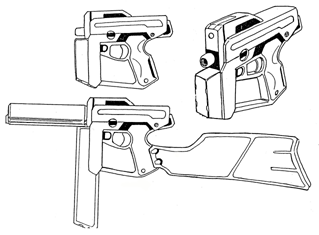

Designation:RRG - Brisbane
|

| 
|

|
||

|
|||||
 |
| A Resistance fighter on Invid-occupied Earth wields an Owens pistol with barrel extension attachment. |
As preparations were underway for the departure of the SDF-3 to Tirolian space, and advance scouting reports trickled in about the nature of the challenges they would face in years ahead, one of the things on the RDF leadership's mind was the next generation of small arms that its troopers would carry. Slug-firing weapons had served mankind well up until the end of the twentieth century, but as mankind's adversaries now included giant humanoids and heavy ceramic-composite battle armor, there was growing concern that even explosive or armor-piercing ammunition might have reached the limit of its effectiveness. The extra weight and bulk that ammunition added to a soldier's pack, and the logistics of resupplying that ammunition, were also significant drawbacks. However, weighed against these concerns and drawbacks was the fact that conventional weapons were the result of centuries of continuous testing and development; their effectiveness was, if sub-optimal, at least a known factor compared to that of personal energy weapons.
Although the RDF had already planned on launching its Expeditionary Force well-equipped with conventional weapons such as the Wolverine assault rifle, Badger submachine gun, and Weasel 9mm pistol, they were also interested in the prospect of phasing them out in favor of more potent energy weapons, if such weapons could be perfected. With this in mind, the Robotech Research Group facilities around the newly-rebuilding world were tasked with developing prototypes for man-portable energy weapons. The REF was especially interested in a new officer's sidearm, in the vein of the Colt 1911, Beretta 92, and M-37 Weasel, but also wanted a multi-shot burst-capable light energy submachine gun to replace the MP-9 and potentially the Badger.
Lieutenant Michael Owens, of the Brisbane branch of the Robotech Research Group, hit upon the idea of developing an energy light machine pistol to fulfil both goals simultaneously, creating a prototype multi-part particle beam weapon that he simply called the Mark I. Owens's superiors believed in assigning credit where credit was due; the final design was submitted for consideration by the RDF as the Owens Mark I—humanity's first completed design for a personal energy weapon. Later nicknamed the "Wolff" by REF soldiers, after the iconoclastic Colonel Jonathan Wolff who carried it exclusively, the Owens had a long and distinguished period of service and is widely recognized as the predecessor to the Gallant H-90.
The Owens is capable of single shot, three-shot burst, and (starting with the Mark V) limited fully-automatic fire in its pistol form. (In practice, the pistol is usually fired strictly on semi-automatic for greater accuracy, heat efficiency, and conservation of charge.) Like many slug-firing machine pistols before it, it accepts a pistol-sized rechargeable capacitor magazine that is flush with the grip, or a longer magazine for twice the capacity. Because the bulk required for a capacitor of sufficient size would make it too large to fit into the handgrip, the magazine receiver is placed forward of the trigger; a buttstock can be attached to steady the weapon for more accurate burst fire. One new innovation of the system is a silencer-like collimator-magnet barrel extension that threads onto the pistol's barrel. Although it has little effect on the sound of the weapon's discharge, this barrel dramatically extends effective range and increases penetration, as well as serving as a heat sink and radiator to allow for longer burst firing without overheating. However, it drains some power from the shots, reducing on-target energies by fifteen percent.
 |
| Colonel Jonathan Wolff fires his signature sidearm. Unidentified soldier at right is firing a Gallant H-90. |
The Owens's pistol capacitor magazine contains sufficient energy for 18 2.0 kJ anti-personnel shots, or 9 4.0 kJ anti-armor shots. The longer capacitor magazine doubles that, to 36 anti-personnel or 18 anti-armor shots. Because of the unbalancing weight of the extended magazine, it is not usually used without the extended stock attachment. Bursts and fully-automatic fire can be used with both power settings; however, extended fully-automatic fire is not recommended on the higher setting due to heat buildup issues unless the heat-sink barrel extension is attached.
One of the most hailed innovations of the Owens was its capacity for field-expedient recharging. Each Owens kit included a small universal adapter, carried in a belt pouch next to the holster (or, in later models, on the holster itself as the device was made smaller). This adapter enabled charging of the Owens magazines from most commercial and residential AC and DC currents, mecha- or vehicle-based power plants, or portable generators. Depending on the nature of the power source, each magazine could be fully recharged in a matter of minutes to tens of minutes. (1) This largely eliminated one of the largest logistical problems in guerilla operations; instead of requiring shipments of bulky ammunition, a covert unit could easily recharge all of its magazines off of a single gasoline or protoculture generator. Another function of the adapter was to allow two the contents of two partly-charged capacitors to be incorporated into one, which could be done much more rapidly.
The Owens went through a number of different models, designated Marks I through XI. Most of the differences were cosmetic. Mark I was the limited-run evaluation prototype, now highly-prized by collectors; only seven are still known to exist in working order. Mark II was a flawed first run, soon recalled and superceded by Mark III. Marks III through V saw stamped-metal casing parts phased out and replaced with molded composite for lighter weight and more ruggedness. The Mark V incorporated a more efficient beam generator design that made possible fully-automatic fire in pistol mode without overheating issues, and enabled access to the fully-automatic mode of the fire selector without requiring the barrel extension to be attached. The Mark VI was the last model to be produced on earth; the Southern Cross did not elect to continue production of the Owens design after the REF departed. The Mark VI was also the largest production run; most of the soldiers who left with the SDF-3 were originally equipped with either Mark V or Mark VI Owens guns. Marks VII through X were produced in more limited numbers by the REF's branch of the RRG in deep space and on Tirol.
Further refinement of the Owens gun ceased in 2028 when its design team was assigned to the new Gallant project, under the direction of then-Colonel Michael Owens. However, the Mark IX and X continued to be manufactured and issued for use in limited REF roles all the way up through the 2040s.
The Owens Mark XI, introduced in 2046 by Owens Firearms Ltd. under the supervision of Brigadier General Michael Owens (Ret.), represents the final version of this weapon, meant for limited military, law-enforcement, and civilian home defense uses. The XI-A variant is the fully-functional military version; XI-B, the civilian model, is capable of semi-automatic, anti-personnel mode fire only (though may be converted to full functionality by qualified weaponsmiths or bio-maintenance engineers).
The Owens remains in limited military service to this day, largely in special forces and counterinsurgency roles due to its ease of field-expedient recharging, or as an infantry support weapon. Officers may still opt to carry an Owens rather than a Gallant as their standard-issue sidearm, though this practice is largely limited to veterans of the Sentinels or Earth Reclamation campaigns.
 |
| A young Resistance fighter uncovers an Owens submachine gun… |
 |
| …and wields it with more enthusiasm than skill. |
The Owens met with a mixed reception on its debut, due partly to flaws in the Mark II production run. The civilian manufacturing contractors who supplied some of its parts were not accustomed to the extremely fine tolerances required for a hand-held energy weapon; they either refined their manufacturing processes or were replaced by the time of the Mark III. (2)
The RDF was satisfied with the Owens once the reliability issues had been overcome; its compactness, energy yield, ruggedness, and versatility made it perfectly suited to the REF's role in exploring the unknown. Subsequently, the REF branch of the RDF adopted the Owens as its standard officer sidearm, and as an infantry support automatic weapon or "mob gun;" it would continue in the standard-issue sidearm role until the introduction of the Gallant in 2030, though it continues to be used in other roles to this day. Even after the Gallant supplanted it as the standard-issue sidearm, many REF officers (such as Jonathan Wolff) continued to carry the Owens instead, preferring the higher stopping power of its 2.0 kJ antipersonnel shot to the Gallant's 1.5 kJ.
However, the leadership of the Southern Cross branch did not see the same immediate need for an energy-based sidearm, since they were going to be dealing primarily with human and micronized-Zentraedi insurgencies rather than actively seeking out potentially hostile and better-equipped alien forces. They were also nonplused at the Owens pistol's boxy shape, feeling this would make it more difficult to draw from a holster at need. Finally, they were doubtful that an energy sidearm would be sufficiently effective against armored foes to merit its adoption, preferring to concentrate on the more powerful carbine or rifle form factors instead. (3) However, many of the Owens design's innovations (such as field-expedient recharging) were subsequently incorporated into larger energy weapons that met with the Southern Cross's approval, most notably the multi-configurable P-20 Variable Aperture Particle Carbine which came out shortly afterward.
Despite the lack of widespread Southern Cross adoption, the Owens Mark II through VI did see limited Southern Cross service in the hands of special forces and recon soldiers, who had a good deal of leeway in the selection of their personal armament. The Owens's compact size for an energy weapon and ruggedness were desirable features, and it could easily be serviced and recharged in the field.
Many Owens guns found their way into the hands of the anti-Invid Resistance movement—from their Southern Cross use, from soldiers who returned with the Pioneer mission to fight the Robotech Masters, and from salvage from wrecked troop carriers of the 10th and 21st Mars Division deployments. The ruggedness, versatility, and rechargeability of this gun, combined with its non-reliance on protoculture that could be detected by the Invid, made it a valued weapon to the freedom fighter who found it. Many Owens guns of varying models are still in civilian hands.
NOTE: As the result of an unfortunate misprint in a 2046 commercial publication, the fully-assembled Owens gun system is often misidentified as the AR-25 Wolverine assault rifle.
(1) Under optimal conditions, a pistol-sized magazine could be charged in just under one minute, a double-sized magazine in two; however, these conditions are not generally encountered outside of mass-charging facilities on bases or in ships.
(2) A replacement-parts conversion kit was issued for the Mark II model; guns modified in this way are referred to as Mark II-A.
(3) In fact, the Southern Cross would never widely adopt any energy weapon smaller than a carbine, issuing the M-37 Weasel, M-39 Mesa Eagle, and M-42 .50 CAP slug-firing pistols as sidearms all the way through the end of the Second Robotech War.
Go to RDF Armor/Weapons Index.
Go to the Robotech Reference Guide Home Page.
Robotech (R) is the property of Harmony Gold. This document is in no way intended to infringe upon their rights.
Content by Peter Walker and Pieter Thomassen, with Chris Meadows and Rob Morgenstern